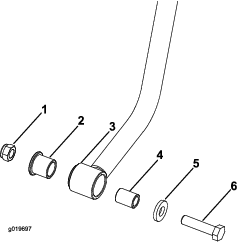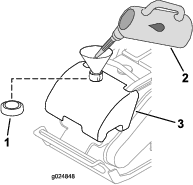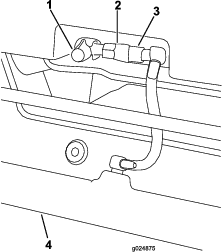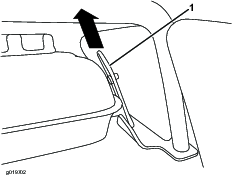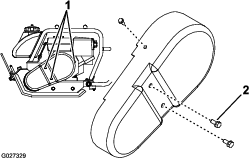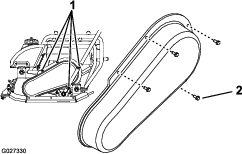| Maintenance Service Interval | Maintenance Procedure |
|---|---|
| Before each use or daily |
|
Introduction
This machine is designed to compact a wide array of soil substances, including clay, silt, gravel, sand, and loam.
Read this information carefully to learn how to operate and maintain your product properly and to avoid injury and product damage. You are responsible for operating the product properly and safely.
You may contact Toro directly at www.Toro.com for product and accessory information, help finding a dealer, or to register your product.
Whenever you need service, genuine Toro parts, or additional information, contact an Authorized Service Dealer or Toro Customer Service and have the model and serial numbers of your product ready. Figure 1 illustrates the location of the model and serial numbers on the product. Write the numbers in the space provided.
Important: With your mobile device, you can scan the QR code on the serial number decal (if equipped) to access warranty, parts, and other product information.
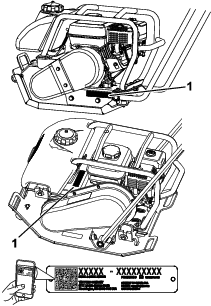
This manual identifies potential hazards and has safety messages identified by the safety-alert symbol (Figure 2), which signals a hazard that may cause serious injury or death if you do not follow the recommended precautions.

This manual uses 2 words to highlight information. Important calls attention to special mechanical information and Note emphasizes general information worthy of special attention.
This engine is not equipped with a spark arrester muffler. It is a violation of California Public Resource Code Section 4442 to use or operate the engine on any forest-covered, brush-covered, or grass-covered land. Other states or federal areas may have similar laws.
Warning
CALIFORNIA
Proposition 65 Warning
The engine exhaust from this product contains chemicals known to the State of California to cause cancer, birth defects, or other reproductive harm.
Use of this product may cause exposure to chemicals known to the State of California to cause cancer, birth defects, or other reproductive harm.
Safety
Improper use or maintenance by the operator or owner can result in injury. To reduce the potential for injury, comply with these safety instructions and always pay attention to the safety alert symbol, which means Caution, Warning, or Danger—personal safety instruction. Failure to comply with the instruction may result in personal injury or death.
Safe Operating Practices
This product is capable of causing serious injury. Always follow all safety instructions to avoid serious injury or death.
Warning
Engine exhaust contains carbon monoxide, an odorless, deadly poison which is lethal if inhaled.
Do not run the engine indoors or in an enclosed area.
Training
-
Read the Operator's Manual and other training material. If the operator(s) or mechanic(s) cannot read or understand the information, it is the owner's responsibility to explain this material to them.
-
Become familiar with the safe operation of the equipment, operator controls, and safety signs.
-
All operators and mechanics should be trained. The owner is responsible for training the users.
-
Never let children or untrained people operate or service the equipment. Local regulations may restrict the age of the operator.
-
The owner/user can prevent and is responsible for accidents or injuries occurring people or damage to property.
Preparation
-
Wear appropriate clothing including hard hat, eye protection, long pants, substantial, slip-resistant footwear, and hearing protection. Tie back long hair, secure loose clothing, and do not wear loose jewelry.
-
Inspect the area where the equipment is to be used and ensure that all objects are removed from the area before use.
-
Use extra care when handling fuel. They are flammable and vapors are explosive.
-
Extinguish all cigarettes, cigars, pipes, and other sources of ignition.
-
Use only an approved container
-
Do not remove the fuel cap or fill the fuel tank while the engine is running or hot.
-
Do not add or drain fuel in an enclosed space.
-
Do not store the machine or fuel container where there is an open flame, spark, or pilot light, such as on a water heater or other appliance.
-
If you spill fuel, do not attempt to start the engine; avoid creating any source of ignition until the fuel vapors have dissipated.
-
-
Check that the shields are attached and functioning properly. Do not operate unless they are functioning properly.
Operation
-
Use your full attention while operating the machine. Do not engage in any activity that causes distractions; otherwise, injury or property damage may occur.
-
Never run an engine in an enclosed or poorly ventilated area.
-
Operate the machine only in good light, keeping away from holes and hidden hazards.
-
Stop on level ground, set the throttle to slow, and shut off the engine before leaving the operator's position for any reason.
-
Ensure that the area is clear of other people before operating the machine. Shut off the machine if anyone enters the area.
-
Keep bystanders out of the operating area. Stop the machine if anyone enters the area.
-
Keep your feet clear of the plate compactor.
-
Do not operate the machine while ill, tired, or under the influence of alcohol or drugs.
-
Do not change the engine governor setting or overspeed the engine.
-
Use care when loading or unloading the machine into a trailer or truck.
-
Do not touch parts which may be hot from operation. Allow them to cool before attempting to maintain, adjust, or service.
-
Lightning can cause severe injury or death. If lightning is seen or thunder is heard in the area, do not operate the machine; seek shelter.
Maintenance and Storage
-
Let the engine cool before storing and do not store the machine near an open flame.
-
Position the machine on a level surface, set the throttle to slow, and shut off the engine. Wait for all movement to stop before adjusting, cleaning, or repairing.
-
Clean debris from drives, mufflers, and the engine to help prevent fires. Clean up oil or fuel spills.
-
Do not store fuel near flames or drain indoors.
-
Never allow untrained personnel to service the machine.
-
Carefully release pressure from components with stored energy.
-
Disconnect the spark plug before making any repairs.
-
Keep hands and feet away from moving parts. If possible, do not make adjustments with the engine running.
-
Keep all parts in good working condition and all hardware tightened. Replace all worn or damaged decals.
-
Keep nuts and bolts tight. Keep equipment in good condition.
-
Stop and inspect the equipment if you strike an object. Make any necessary repairs before restarting.
-
Use only genuine Toro replacement parts to ensure that original standards are maintained.
Safety and Instructional Decals
 |
Safety decals and instructions are easily visible to the operator and are located near any area of potential danger. Replace any decal that is damaged or missing. |
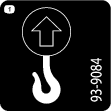



Setup
Installing the Handle
Checking the Engine-Oil Level
The machine comes from the factory with oil in the engine crankcase; however, it may be necessary to add oil; refer to Checking the Engine-Oil Level. Add only enough oil to raise the level to the Full mark on the dipstick.
Checking the Eccentric-Oil Level
The machine comes from the factory with eccentric oil in the eccentric housing; however, it may be necessary to add oil; refer to Servicing the Eccentric Oil. Add only enough oil so that the oil level is flush with the oil plug on the side of the eccentric housing.
Product Overview
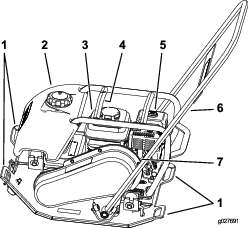
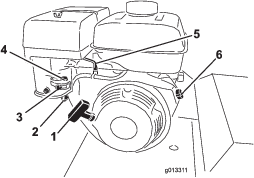
Operation
Note: Determine the left and right sides of the machine from the normal operating position.
Checking the Engine-Oil Level
Oil crankcase capacity:
-
0.56 L (0.59 US qt) for Model 68025
-
0.58 L (0.61 US qt) for Models 68026 and 68027
-
Position the machine on a level surface.
-
Set the throttle to slow, shut off the engine, and wait for all moving parts to stop.
-
Clean around the dipstick so that dirt cannot fall into the filler hole and damage the engine (Figure 7).
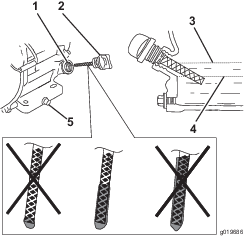
-
Remove the dipstick and wipe the end clean.
-
Slide the dipstick fully into the dipstick tube without threading it into the filler neck.
-
Pull the dipstick out and inspect the end.
Note: The oil should be level with the upper-limit mark (Figure 7).
Important: Running the engine with a low oil level can cause engine damage. This type of damage is not covered by warranty.The engine is equipped with an oil alert system that will automatically shut off the engine before the oil level falls below the safe limit.
-
If the oil level is low, slowly pour only enough oil into the crankcase to raise the level to the upper limit.
Important: Do not overfill the crankcase with oil, because the engine may be damaged.
-
Install and secure the dipstick.
Cleaning Debris from the Machine
| Maintenance Service Interval | Maintenance Procedure |
|---|---|
| Before each use or daily |
|
-
Set the throttle to slow, shut off the engine, and wait for all moving parts to stop.
Warning
Contact with hot parts on the machine can cause severe burns.
Wait for all parts to cool before touching the machine.
-
Brush dirt and debris away from the air cleaner and engine openings.
-
Check the sprinkler manifold (Figure 10) and remove any dirt or debris.
Adding Fuel
-
For best results, use only clean, fresh (less than 30 days old), unleaded gasoline with an octane rating of 87 or higher ((R+M)/2 rating method).
-
Ethanol: Gasoline with up to 10% ethanol (gasohol) or 15% MTBE (methyl tertiary butyl ether) by volume is acceptable. Ethanol and MTBE are not the same. Gasoline with 15% ethanol (E15) by volume is not approved for use. Never use gasoline that contains more than 10% ethanol by volume, such as E15 (contains 15% ethanol), E20 (contains 20% ethanol), or E85 (contains up to 85% ethanol ). Using unapproved gasoline may cause performance problems and/or engine damage which may not be covered under warranty.
-
Do not use gasoline containing methanol.
-
Do not store fuel either in the fuel tank or fuel containers over the winter unless a fuel stabilizer is used.
-
Do not add oil to gasoline.
Danger
In certain conditions, fuel is extremely flammable and highly explosive. A fire or explosion from fuel can burn you and others and can damage property.
-
Fill the fuel tank outdoors, in an open area, when the engine is cold. Wipe up any fuel that spills.
-
Never fill the fuel tank inside an enclosed trailer.
-
Do not fill the fuel tank completely full. Add fuel to the fuel tank until the level is 6 to 13 mm (1/4 to 1/2 inch) below the bottom of the filler neck. This empty space in the tank allows fuel to expand.
-
Never smoke when handling fuel, and stay away from an open flame or where fuel fumes may be ignited by a spark.
-
Store fuel in an approved container and keep it out of the reach of children. Never buy more than a 30-day supply of fuel.
-
Do not operate without entire exhaust system in place and in proper working condition.
Danger
In certain conditions during fueling, static electricity can be released causing a spark which can ignite the fuel vapors. A fire or explosion from fuel can burn you and others and can damage property.
-
Always place fuel containers on the ground away from your vehicle before filling.
-
Do not fill fuel containers inside a vehicle or on a truck or trailer bed because interior carpets or plastic truck bed liners may insulate the container and slow the loss of any static charge.
-
When practical, remove gas-powered equipment from the truck or trailer and refuel the equipment with its wheels on the ground.
-
If this is not possible, then refuel such equipment on a truck or trailer from a portable container, rather than from a fuel dispenser nozzle.
-
If you must use a fuel dispenser nozzle, keep the nozzle in contact with the rim of the fuel tank or container opening at all times until fueling is complete.
Warning
Fuel is harmful or fatal if swallowed. Long-term exposure to vapors can cause serious injury and illness.
-
Avoid prolonged breathing of vapors.
-
Keep face away from nozzle and gas tank or conditioner bottle opening.
-
Avoid contact with skin; wash off spills with soap and water.
Using Stabilizer/Conditioner
Use a fuel stabilizer/conditioner in the machine to provide the following benefits:
-
Keeps fuel fresh during storage of 90 days or less. For longer storage it is recommended that the fuel tank be drained.
-
Cleans the engine while it runs
-
Eliminates gum-like varnish buildup in the fuel system, which causes hard starting
Important: Do not use fuel additives containing methanol or ethanol.
Add the correct amount of gas stabilizer/conditioner to the gas.
Note: A fuel stabilizer/conditioner is most effective when mixed with fresh fuel. To minimize the chance of varnish deposits in the fuel system, use fuel stabilizer at all times.
Filling the Fuel Tank
-
Set the throttle to slow, shut off the engine, and wait for all moving parts to stop.
-
Allow the engine to cool.
-
Clean around the fuel tank cap and remove it (Figure 8).
Note: The cap is tethered to the fuel tank.
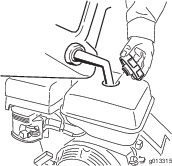
-
Add unleaded fuel to the fuel tank until the level is just inside the mesh filter basket.
Important: This space in the tank allows fuel to expand. Do not fill the fuel tank completely full.
-
Install the fuel tank cap securely.
-
Wipe up any spilled fuel.
Compacting Asphalt
When using the machine on asphalt, the water system is used to wet the surface of the compactor to prevent the asphalt from sticking to the compactor.
Adding Water with the Tank Installed
Starting the Engine
-
Move the engine switch to the ON position (Figure 12).
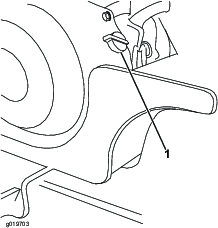
-
Move the fuel valve to the ON position (Figure 13).
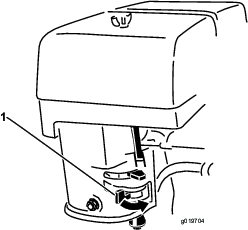
-
Move the choke lever to the left if you are starting a cold engine (Figure 14).
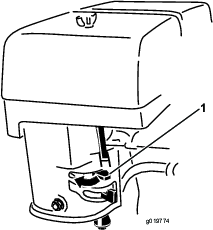
-
Move the throttle lever midway between the SLOW (turtle) and FAST (rabbit) positions (Figure 15).
Note: A warm or hot engine may not require choking.
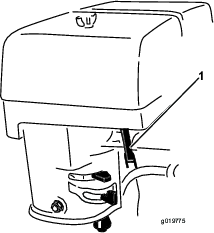
-
Pull the recoil handle sharply to start the engine.
-
After the engine starts, gradually move the choke to the right.
Important: If the engine stalls or hesitates, move the choke left again until the engine warms up.
-
Move the throttle lever to maximum throttle.
Shutting Off the Engine
-
Move the throttle lever to the SLOW (turtle) position.
-
Turn the engine switch and fuel valve off.
Operating the Compactor
With the engine at full throttle, the compactor moves forward while vibrating.
Grasp the handle lightly with both hands and allow the compactor to move forward on its own. Use the handle to guide the direction of travel to avoid obstructions.
Transporting the Machine
Model 68025 weighs 64 kg (140 lb)
Model 68026 weighs 93 kg (205 lb)
Model 68027 weighs 98 kg (215 lb)
You can use the rollcage lifteye to lift and transport the machine with straps or a crane (Figure 16).
Alternatively, 2 people can transport the machine by lifting the compactor using the front and rear lift handles (Figure 16).

Maintenance
Recommended Maintenance Schedule(s)
| Maintenance Service Interval | Maintenance Procedure |
|---|---|
| After the first 25 hours |
|
| Before each use or daily |
|
| Every 50 hours |
|
| Every 100 hours |
|
| Every 200 hours |
|
| Every 300 hours |
|
| Monthly |
|
Disconnecting the Spark-Plug Wire
Before performing any maintenance on the engine, disconnect the spark-plug wire from the spark plug (Figure 17).
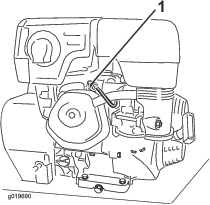
Engine Maintenance
Servicing the Spark Plug
| Maintenance Service Interval | Maintenance Procedure |
|---|---|
| Every 100 hours |
|
| Every 200 hours |
|
Use an NGK BPR6ES spark plug or equivalent.
-
Shut off the engine and wait for all moving parts to stop.
-
Disconnect the wire from the spark plug.
-
Clean around the spark plug.
-
Remove the spark plug from the cylinder head.
Important: Replace a cracked, fouled, or dirty spark plug. Do not clean the electrodes because grit entering the cylinder can damage the engine.
-
Set the gap on the plug to 0.76 mm (0.03 inch) as shown in .

-
Carefully install the spark plug by hand (to avoid cross threading) until it is hand tight.
-
Tighten the spark plug an additional 1/2 turn if it is new; otherwise, tighten it an additional 1/8 to 1/4 turn.
Important: A loose spark plug can become very hot and can damage the engine; overtightening a spark plug may damage the threads in the cylinder head.
-
Connect the wire to the spark plug.
Servicing the Air Cleaner
| Maintenance Service Interval | Maintenance Procedure |
|---|---|
| Before each use or daily |
|
| Every 50 hours |
|
| Every 300 hours |
|
Removing the Air Filter
Important: Do not operate the engine without the air filter assembly; extreme engine damage will occur.
-
Set the throttle to slow, shut off the engine, and wait for all moving parts to stop.
-
Disconnect the spark-plug wire from the spark plug.
-
Wipe the air filter cover (Figure 19) so that it is clean.
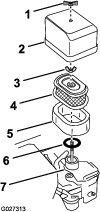
-
Remove the wing nut that secures the air-filter cover to the carburetor and remove the cover (Figure 19).
Note: Be careful to prevent dirt and debris from falling into the base.
-
Remove the foam filter element from the paper filter element (Figure 19).
-
Inspect the foam element for damage.
Note: If the foam filter element is damaged, replace it. If the foam element is dirty, clean it; refer to Cleaning the Foam Filter.
-
Remove the wing nut that secures the paper filter element to the carburetor (Figure 19).
-
Remove the paper element and inspect the paper filter element for damage and excessive amounts of dirt in the element.
Note: Replace the paper filter element if it is damaged or excessively dirty.
Note: Never try to clean the paper element; only replace it.
Cleaning the Foam Filter
-
Clean the foam filter element in warm soapy water and rinse the element in clean water, or clean the foam filter element in a nonflammable solvent.
Note: Do not use fuel to clean the foam element because it could create a risk of fire or explosion.
-
Allow the foam filter element to completely dry.
-
Dip the foam element in clean engine oil, then squeeze out the excess oil.
Note: If too much oil is left in the foam element when the engine is started, the engine will smoke. Excess oil in the foam element may also restrict the air flow through the element and may reach the paper filter and clog it.
-
Assemble the foam element onto the paper filter element (Figure 19).
Installing the Air Filter
-
Wipe clean the dirt from the carburetor base and the inside of the cover with a moist rag (Figure 19).
Note: Do not allow dirt and debris to enter the air duct leading into the carburetor.
-
Ensure that the rubber gasket is aligned and seated onto the mounting base of the carburetor (Figure 19).
Note: The rubber gasket might stick to the bottom of the old paper filter element. Remove it from the old paper element and install it onto the carburetor.
-
Align the paper filter element with the carburetor and ensure that the hold-down rod of the carburetor passes through the top plate of the filter (Figure 19).
-
Secure the filter to the carburetor with the filter wing nut and tighten it finger tight (Figure 19).
-
Align the air-filter cover over the air filter elements with the hold-down rod of the carburetor passing through the top cover (Figure 19).
-
Secure the cover to the engine with the cover wing nut and tighten it finger tight (Figure 19).
Cleaning the Sediment Cup
| Maintenance Service Interval | Maintenance Procedure |
|---|---|
| Every 100 hours |
|
Danger
In certain conditions, fuel is extremely flammable and highly explosive. A fire or explosion from fuel can burn you and others and can damage property.
-
Set the throttle to slow, shut off the engine and keep heat, sparks, and flame away.
-
Handle fuel only outdoors.
-
Wipe up spills immediately.
-
Do not smoke while handling fuel.
-
Shut off the engine and wait for all moving parts to stop.
-
Disconnect the wire from the spark plug.
-
Move the fuel-shutoff valve to the OFF position.
-
Remove the sediment cup and O-ring (Figure 6).

-
Wash the sediment cup in a nonflammable solvent and dry it thoroughly.
-
Place the O-ring in the fuel valve and install the sediment cup, tightening it securely.
-
Move the fuel-shutoff lever to the On position.
Note: If any fuel leaks, repeat this procedure and replace the O-ring.
Servicing the Engine Oil
Oil Type: Detergent oil (API service SJ or higher)
Oil crankcase capacity:
-
0.56 L (0.59 US qt) for Model 68025
-
0.58 L (0.61 US qt) for Models 68026 and 68027
Viscosity: See table below
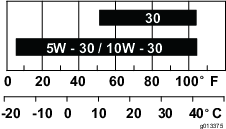
Changing the Engine Oil
| Maintenance Service Interval | Maintenance Procedure |
|---|---|
| After the first 25 hours |
|
| Every 100 hours |
|
Warning
Oil may be hot after the engine has been run, and contact with hot oil can cause severe personal injury.
Avoid contacting the hot engine oil when you drain it.
-
Shut off the engine and wait for all moving parts to stop.
-
Disconnect the wire from the spark plug.
-
Remove the drain plug (Figure 22).
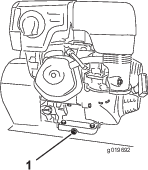
Note: You may have to tip the compactor backwards to drain the oil.
-
When the oil has drained completely, replace the plug.
Note: Dispose of the used oil at a certified recycling center.
-
Remove the dipstick (Figure 7) and slowly pour oil into the filler hole until the oil pours out of the filler hole.
-
Replace and secure the dipstick.
-
Wipe up any spilled oil.
Servicing the Eccentric Oil
Oil type: 10W30 (API service SJ or higher)
Oil capacity:
-
1.3 L (1.4 US qt) for Model 68025
-
3.3 L (3.5 US qt) for Model 68026
-
3.5 L (3.7 US qt) for Model 68027
Checking the Eccentric-Oil Level
| Maintenance Service Interval | Maintenance Procedure |
|---|---|
| Monthly |
|
-
Set the throttle to slow, shut off the engine, and wait for all moving parts to stop.
-
Place a drain pan under the oil plug and remove the oil-plug screw on the side of the eccentric housing (Figure 23).
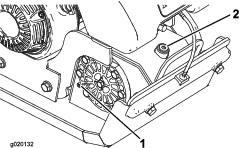
-
Verify that the eccentric oil is level with the bolt hole.
-
Wipe up any spilled oil.
-
Replace the oil-plug screw.
Changing the Eccentric Oil
| Maintenance Service Interval | Maintenance Procedure |
|---|---|
| Every 300 hours |
|
-
Set the throttle to slow, shut off the engine, and wait for all moving parts to stop.
-
Place an oil drain pan under the oil plug and remove the fill plug and the oil plug screw (Figure 23).
-
Tip the plate compactor forward slightly and use a suction gun to remove the oil through the filler hole (Figure 23).
-
Slowly pour oil into the filler hole until the oil comes out the oil plug (Figure 23).
-
Wipe up any spilled oil.
-
Replace the fill plug and the oil plug screw.
Belt Maintenance
Removing the Belt Cover
Checking the Belt Tension
| Maintenance Service Interval | Maintenance Procedure |
|---|---|
| Every 100 hours |
|
Important: The best belt tension for the machine is the lowest tension at which the belts do not slip under full power.
-
Lay a straight edge on the belt and across the pulleys (Figure 26).
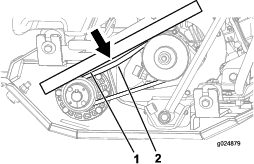
-
With a force gauge, push down on the belt, midway between the pulleys (Figure 26).
Note: The belt should deflect 7.6 mm (0.3 inch) from the straight edge when pushing down on the belt with 1.4 to 2.3 kg (3 to 5 lb) of force (Figure 26).
Note: If the belt tension is too low or too high, adjust the belt tension; refer to Adjusting the Belt Tension.
Adjusting the Belt Tension
-
Remove the water tank; refer to Adding Water with the Tank Removed.
-
Loosen the 2 hex-socket bolts (5/16-24 x 1.75 inches) that secure the front of the engine (Figure 27).

-
Loosen the 2 flange nuts (8 mm) that secure the back of the engine (Figure 28).
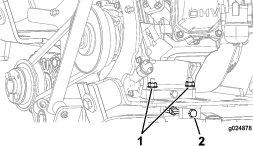
-
Loosen the jam nut, and rotate the belt-tensioning bolt clockwise to tension the belt, or rotate the belt-tensioning bolt counterclockwise to loosen the tension on the belt (Figure 28).
-
Check the belt tension; refer to Checking the Belt Tension.
-
When the correct tension is reached, tighten the jam nut on the belt-tensioning bolt.
-
Tighten the 2 hex-socket bolts (5/16-24 x 1-3/4 inches) that secure the front of the engine to 12.5 to 16.4 N∙m (9.2 to 12.1 ft-lb) as shown in Figure 27.
-
Tighten the 2 flange nuts (8 mm) that secure the back of the engine to 23 to 29 N∙m (17 to 21 ft-lb) as shown in Figure 28.
-
Apply medium-grade thread-locking compound to the threads of the flanged-head bolts that you removed in step 1 of Removing the Belt Cover.
-
Align the belt cover to the machine and secure the cover with the flanged-head bolts that you removed in step 1 of Removing the Belt Cover.
-
Torque the bolts to 972 to 1198 N∙cm (86 to 106 in-lb).
Storage
-
Shut off the engine and disconnect the spark-plug wire from the spark plug.
-
Remove dirt and grime from the entire machine.
Important: You can wash the machine with mild detergent and water. Do not pressure wash the machine. Avoid excessive use of water, especially near the engine.
-
Service the air cleaner; refer to Servicing the Air Cleaner.
-
Change the engine oil; refer to Changing the Engine Oil.
-
For storage over 30 days, prepare the unit as follows:
-
Add a petroleum-based fuel stabilizer/conditioner to fuel in the tank. Follow mixing instructions from stabilizer manufacturer (1 fl oz per gallon). Do not use an alcohol-based stabilizer (ethanol or methanol).
Note: A fuel stabilizer/conditioner is most effective when mixed with fresh fuel and used at all times.
-
Run the engine until it stops from running out of fuel.
-
Choke the engine.
-
Start and run the engine until it does not start again.
-
Dispose of fuel properly. Recycle as per local codes.
Important: Do not store stabilizer/conditioned fuel over 90 days.
-
-
Check and tighten all bolts, nuts, and screws. Repair or replace any part that is damaged.
-
Paint all scratched or bare metal surfaces. Paint is available from your Authorized Service Dealer.
-
Store the machine in a clean, dry garage or storage area.
-
Cover the machine to protect it and keep it clean.
Troubleshooting
| Problem | Possible Cause | Corrective Action |
|---|---|---|
| The engine does not start, starts hard, or fails to keep running. |
|
|
| The plate does not vibrate at full speed. |
|
|
| The clutch is extremely hot. |
|
|
| The plate does not vibrate when the engine is running. |
|
|
| There is insufficient water flow. |
|
|
